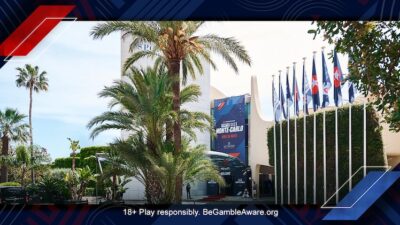Not all players will admit to it, but no one, absolutely no one, wants to bust a final table first — and it’s the guys in the middle who get squeezed the most.
The big stacks have the chips to allow for a couple of mis-steps, while the short stacks can do their best to ladder up. But it’s the players who maybe have hopes of pushing into contention who will be nervously eyeing the payout ladder, wondering what their best strategy is, especially if a bully starts applying the pressure.
In this tournament, for instance, the pay jump between eighth and seventh is £24,000, which is not to be sniffed at. And the players with a medium-sized stack, in positions six and seventh in the leader board, are in a real bind, especially as they grapple with ICM considerations.
As level 28, with blinds of 30,000/60,000 ante 10,000 started it was Jonathan Bensadoun (1,120,000, 18.66 big blinds) and Pablo Gordillo (1,360,000, 22.66 big blinds) who found themselves in this awkward spot. The PokerStars Blog isn’t an expert in traversing such a sticky, tricky landscape but luckily we know a man who is.
“They have to tighten up a bit, but it depends on who you’re going up against in a hand and if they can knock you out,” says David Lappin, who’s part of the Firm and railing Kevin Killeen. “The guy in eighth place has absolutely no ICM considerations other than that he’s trying to make life awkward by hanging around and he is being patient.
“On the other side of the equation the chip leader is taking advantage of this and he’s trying to pick up soft chips because players aren’t going to be able to play back as much. For instance if Sebastian Pauli (the chip leader) opens from the cut-off, Jake Cody isn’t going to defend as widely from the big blind as he might do because he doesn’t want to get into a potential big ICM punt with him.”
But it’s not just the players in sixth and seventh who have ICM considerations. “I think the guys who are in second through fifth are really wary about getting into pots with players who can knock them out, whereas sixth and seventh are focused on outlasting the shortstack,” Lappin says. “They have pretty significant ICM considerations.”
He continues: “Some people can take that too far though. In their position, while a lot of their money is locked into two ladder spots some of their equity is in the top two or three prizes as well.”
So typically what adjustments do you need to make when you’re in the 15-20 big blind zone but you aren’t the shortest stack?
“You can’t turn down premium hands but ICM considerations will dictate that you should proabably fold the bottom 5% of your range that you’d usually re-shove with,” Lappin says. “Also your induce range is going to be a lot tighter. With a 14-20 big blind stack with ace-queen, ace-jack suited, eights and nines, you’d usually open those hands so a worse range will re-ship. But in this situation you’d just open shove them. So your inducing range gets narrower because more of that range will come into your open shove range because you want to avoid showdown if you can. If you simply open shove a hand like eights, instead of opening it with the intention of calling it off, you avoid situations where a king-queen, ace-nine type hand will reship on you.”
As well as where you stand in the chip charts, it is also a case of size matters.
“One of the key things to remember is your stack size because if it is in a certain zone then that will affect your decision more than anything else,” Lappin says. “Say the short-stack is as low as seven big blinds and you’re in sixth or seventh with 14 or 15 big blinds. You’re paralysed, because you’re waiting for him to make his move first because you want to make that ladder jump. That’s a really bad spot.”
And it’s often here that the pros really know what to do. “What you’ll find is good players like Jake Cody and Kevin MacPhee if they’re up against the big stack or each other, they won’t have a big three-bet range as they’ll flat their monsters. If the big stack opens and they’re sitting there with ace-queen, that’s usually a nice three-bet spot to induce or play a bigger pot. They’re going to flat that all day as they want to keep the pot smaller and not put too much of their stack at risk.”
As it stands nobody is. We’ve still got a full compliment of players here in London.
Follow our coverage of the EPT London festival via the main EPT London page, where there are hand-by-hand updates and chip counts in the panel at the top and feature pieces below. And, of course, you can follow it all live at EPT Live.
Back to Top






